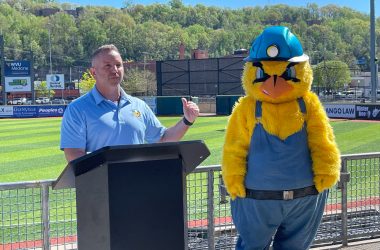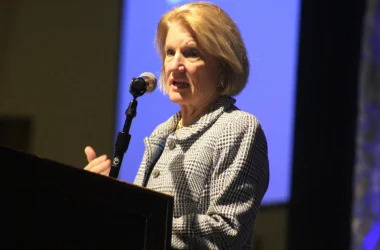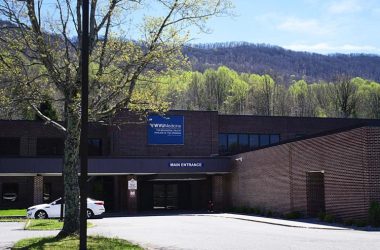By LISA SHREWSBERRY
The State Journal
CHARLESTON, W.Va. — Although heart disease often dominates West Virginia’s woeful health headlines, lung disease remains a brutal reality.

(Photo courtesy of Shelley Taylor)
West Virginia has one of the highest rates of lung and bronchus cancer in the United States — 82.8 per 100,000 people, according to 2015 figures from the West Virginia Bureau for Public Health.
The crisp Mountain State air has not shielded its residents from diseases such as chronic obstructive pulmonary disease, lung cancer or asthma. And as with most health afflictions, individual choice remains the most powerful tool in avoiding lung disease, whether one has a genetic predisposition or not.
“By far the top causative factor of lung disease in West Virginia is cigarette smoking, as there are on average 1,200 smoking-related deaths in West Virginia annually,” Gupta said.
As a consequence, agencies across the state still allocate significant resources toward getting residents to kick the cigarette habit.
“The prevalence of current adult smokers in West Virginia was 27.3 percent in 2013, compared to 18.1 for the U.S., making West Virginia No. 1 in the nation,” Gupta said.
But there appears to be light at the end of the dismal eight-years-long tunnel of leading the nation in adult smoking rates.
“Most recent data demonstrate that West Virginia has seen a dramatic decrease in pregnant women who smoke, from 28.2 percent in 2014 to 24.2 percent in 2016,” Gupta said.
Gupta attributes that step in the right direction to collaboration led by the Bureau for Public Health.
“For example, the launch of the West Virginia Management of Maternal Smoking Initiative, which includes representatives from DHHR programs, the West Virginia Perinatal Partnership, U.S. Centers for Disease Control and Prevention, Substance Abuse and Mental Health Services Administration, U.S. Department of Health and Human Services and the Centers for Medicare and Medicaid Services, has had a major impact,” he said.
Cigarettes: A Smoking Gun
As smoking rates decline across populations, so will the incidence of lung disease in West Virginia.
“When we consider lung diseases, smoking has been well-established as the main cause of chronic obstructive pulmonary disease,” Gupta said. “Because smoke is inhaled and its components are deposited and absorbed in the lungs, it has long been linked to adverse effects on the respiratory system, causing malignant and nonmalignant diseases, exacerbating chronic lung diseases and increasing the risk for respiratory infections.”
But West Virginia isn’t alone in the lung disease battle.
“States with high smoking rates are the same states that have the highest COPD rates,” Gupta said. “Other COPD risk factors that contribute to the state-by-state variation are occupational exposure and income level.”
That statement is backed by statistics from the CDC: States with the highest COPD rates also have some of the lowest median incomes.
“The highest rates of COPD occur among people who are making less than $25,000 a year or who are unemployed,” Gupta added. “Additionally, research shows that the lower your education level, the greater your risk for developing COPD.”
As West Virginia’s state health officer, Gupta has ensured addressing tobacco use in communities remains a crucial part of the State Health Improvement Plan, along with obesity and substance abuse.
“We are committed to working with physicians across the state, schools, local health departments, insurance providers and community partners to inform our families, friends and neighbors that smoking and tobacco use causes serious, life-threatening disease,” he said. “Smoking-related diseases and much of the lung disease we see in West Virginia is preventable. Having smoke-free policies in our communities and workplaces, coupled with providing accurate information pertaining to disease and illness, is making a difference in our family well-being.”
Kicking the Habit
The West Virginia Tobacco QuitLine is one tool Gupta recommends for information about nicotine replacement therapies and tobacco cessation counseling.
“I would recommend those who smoke and want to quit speak to their health care provider about quitting, and come up with a plan that can help them accomplish that goal, which will ultimately improve their quality of life and help reduce the risk of life-threatening disease,” he said.
Those coping with the loss of lung function from their tenure in the mining industry also have treatment options.
“The West Virginia Black Lung Clinics Program services continue to be provided in the state with funding from the Health Resources and Services Administration, an agency of the U.S. Department of Health and Human Services and the state of West Virginia,” Gupta said. “Pulmonary rehabilitation sites have been added in the state providing health access for miners with black lung, COPD, pneumoconiosis and other pulmonary conditions. Primary care services are available where black lung clinics in federally qualified health centers are located, creating access to health care.”
Overshadowed Need
National marketing campaigns emphasizing screening for “popular” cancers may have overshadowed awareness of the need for preventative screenings for lung cancer, according to Chantal Fields, area director for the American Lung Association.
“People tend to ignore lung diseases until they have a personal experience with them,” she said. “Normally, breast cancer is identified as the No. 1 cancer in women, but lung cancer is their No. 1 killer. Breast cancer is actually fairly survivable.
“With lung cancer, by the time people get diagnosed, it is almost always fatal. Pushing for early diagnosis and screening for those with risk factors is a large focus for us.”
Fields appreciates the strides made in the past couple of decades through public awareness of tobacco’s harmful effects and a smoking cessation focus, especially for youth.
“The state had a 45 percent youth rate of smoking that is down now to 16, 17 percent,” she said. “The decision to start is generally made by kids.”
The average starting age of those who choose to smoke in West Virginia is 12.
“We are still focusing a lot of energy on keeping kids from starting, and we will eventually see a shift in adult numbers because of that,” said Fields.
The American Lung Association is dedicated not only to awareness and prevention, but also to support of those with lung disease.
“Patients are terrified when they are first diagnosed with lung disease,” Fields said. “One of the nicest services the ALA offers is a free help line staffed with those who can talk to you and give specialized information about your diagnosis. The public can ask whatever questions they have.”
The American Lung Association Helpline is 1-800-LUNGUSA.
Second Wind
There is a regional connection between a man and his job that is hard to explain, harder to deny and impossible to separate. West Virginia workers have had a conjoined destiny with the coal they have mined for centuries. Partly heritage, partly the allure of an incomparable starting salary, coal miners risk life, limb and lung for the industry that supports their families and scaffolds their identity.
Cigarette smoking owns the lion’s share of blame for the state’s high number of lung disease cases, but a 2014 report from the National Institute for Occupational Safety and Health on central Appalachia highlighted a spike in one of the most deadly forms of pneumoconiosis, commonly known as black lung. According to 2016 U.S. Department of Labor figures, West Virginia coal miners have received more dollars paid in Part C Black Lung disbursements than any other state since 1973.
One still-proud miner whose lungs suffered because of his 23 years underground is Ronald Hatfield of Beckley. Hatfield underwent a lung transplant Oct. 2. His donor lungs have given him a second chance at the rest of his life, but if given the opportunity to go back in time and choose another profession, he doesn’t know if he would.
“I started in the mines in 1976, and I never even thought about it. You just went to work,” he said. “You wanted to get a good pay day, and that’s all you thought about. You never thought about catching it.”
Hatfield sits on his couch, considering a picture of his grandchildren on the far wall, and recalls all he has been through in the past three months — some things, like his ICU stay, he cannot remember. Hatfield has only recently regained his ability to speak. He wears a surgical mask to keep from inhaling contagions that might threaten his compromised immune system.
“I know mines have come a lot farther than what they used to be … they are a lot different today,” Hatfield said. “I liked working in the coal mines. But it sure done a number on me. I don’t know if I would do it again or not; it’s all different now.”
Before black lung, Hatfield was 210 pounds strong. At the height of his disease, his body incinerated calories in the struggle to breathe, reducing him to 138 pounds before surgery. After surgery, Hatfield weighed 114 pounds. Although his larynx is still partially paralyzed from the procedure, his new lungs have taken him from being unable to walk to the bathroom to logging five laps around the inside of his home.
To have another’s organs operating as one’s own — to take a part of a person while another family was actively grieving him or her, these had always seemed like unnatural gifts to Hatfield — both the giving and the taking.
“The Bible don’t talk about it, and I figured, well, maybe that’s how I ought to be,” he said. “I never was much for organ donation, but I am now. It saved my life, and I hope my story will change other people’s outlook. If it wasn’t for a donor, I wouldn’t be here.”
Stephanie Vance, Hatfield’s daughter, spent three months in Pittsburgh while her father worked to become stable enough after surgery to return home.
“They tell you at UPMC what you will have to go through,” she said. “They scare you, and you think, ‘I don’t know if I should have this done or not.’ After you have it done, it’s worse than what they tell you.”
Vance was allowed to see pictures of her father’s lungs after they were removed.
“They were black,” she said. “They looked like steak that was completely burned.”
Hatfield lifts his shirt to show a well-healed, wave-shaped scar beneath his breastbone.
“It was the hardest thing I have been through in my life,” he said. “I traded my oxygen tank for about 30 pills a day … and I ain’t complaining. I had to get something done. I couldn’t take off out of here and leave my grandbabies.”
The X-Factor
Lung disease can happen to anyone, anywhere and in any of many forms or diseases. It can be triggered by environmental hazards, a genetic predisposition or without invitation or explanation.
It started with a cough for John Helmondollar. Helmondollar, also a Raleigh County resident, never worked in a coal mine. He was a truck driver for a hardware store. When he was only in his 30s, the persistent hack that interrupted his daily activities led him to be first diagnosed with pneumonia. He had no family history of lung disease to note. Symptoms unrelenting, his pulmonologist referred him to the University of Virginia Medical Center in Charlottesville for answers, where doctors, thinking his ailment to be cancer or a strange virus, took a biopsy — a piece of his lung tissue for diagnostic testing.
Taking a detailed history of Helmondollar’s environment, both at home and work, doctors scrutinized his day-to-day routine in hopes of discovering the source of his mysterious respiratory illness.
“They took samples of the soil because I lived beside a vineyard and they thought maybe it was pesticides … but there was nothing,” he said. “I had an exotic bird, but that wasn’t it.”
The diagnosis was finally confirmed as idiopathic pulmonary fibrosis.
Idiopathic meant “no one knows” how the disease happened. Pulmonary fibrosis meant Helmondollar’s lungs were irreparably scarred and would progressively worsen. He was a candidate for a lung transplant and was placed on a list to wait for a suitable donor.
“Back then (in 1999), they gave you a beeper, and if the beeper went off, you knew ‘uh-oh, it’s time to go.’”
Helmondollar compares his packed suitcases to the preparations of an expectant mother, only instead of giving life, he was receiving it. Helmondollar, who tried to maintain a sense of normalcy despite fighting for every breath, worked until the day he received the crucial beep. After enduring a single lung transplant, three years later in 2002 he received a second lung from a different donor.
“I would do it all again in a second,” he said.
Helmondollar said he was told at UVA he is the oldest living transplant recipient with lungs from two different donors. The 30-plus pills he takes each day to suppress his body’s immune response to the two strange lungs inside him are negligible, he says, considering the cost of not having them.
He prayed to live until his two children graduated high school. Today, they’re grown and Helmondollar has a new goal — to see his three grandchildren graduate.
“I do just about what I want; it takes longer to do it sometimes,” he said. “I just put in a water heater by myself yesterday — it took me all day, but I did it.”
See more from The State Journal





